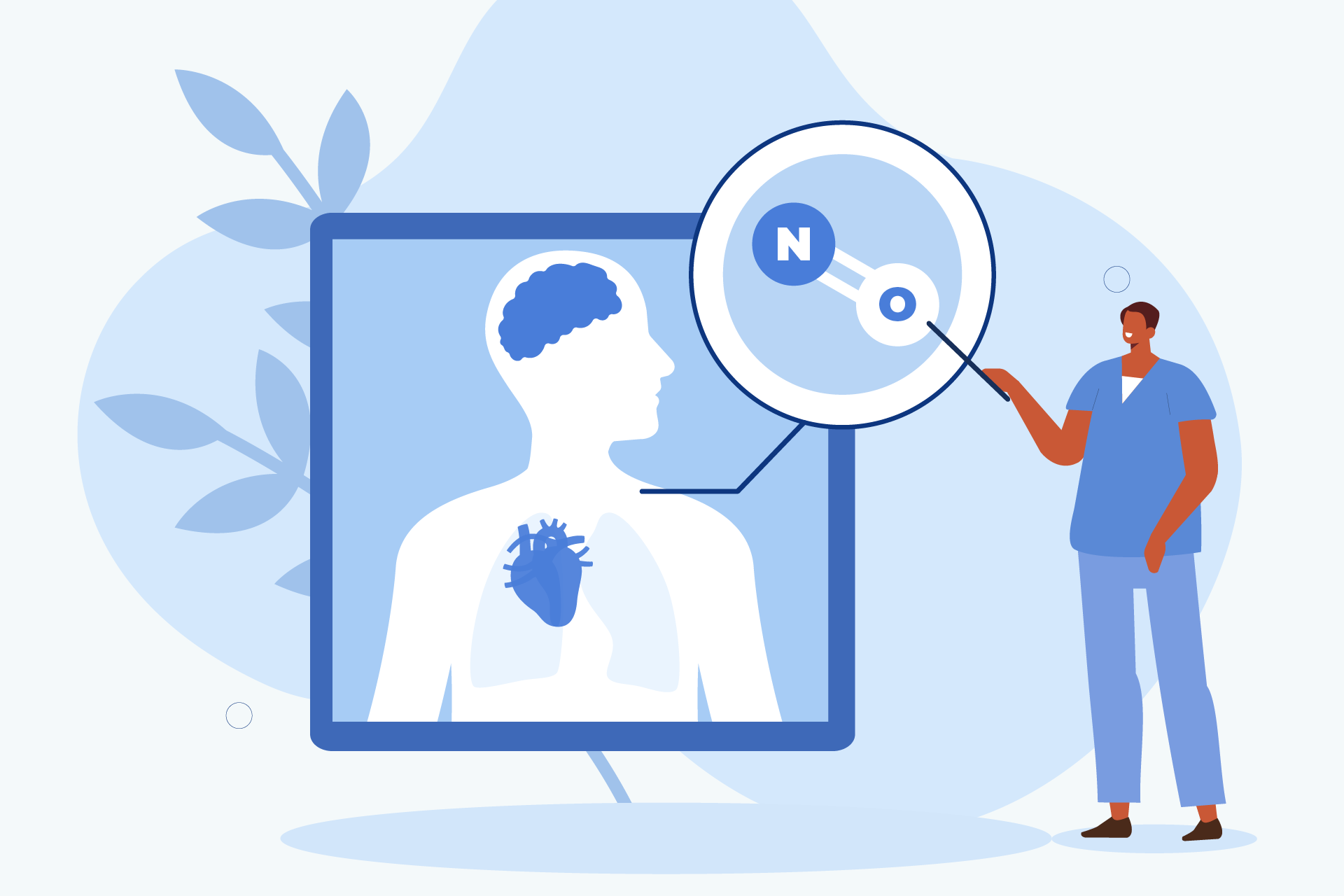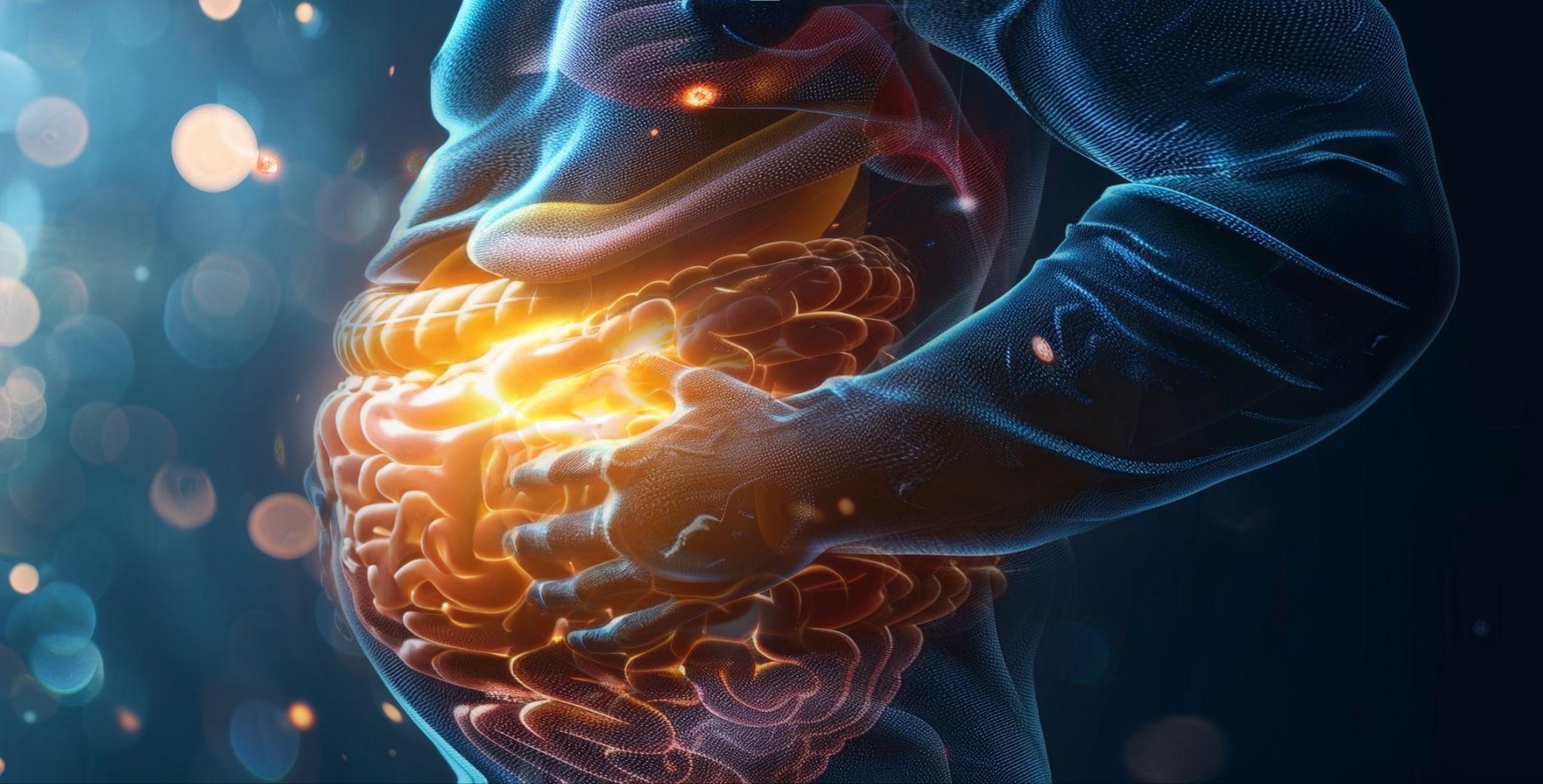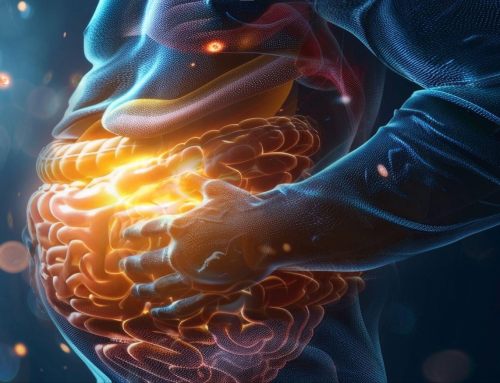What is the Role of Nitric Oxide and How Does It Impact Health?
Nitric oxide is a critical signaling molecule and gaseous cellular messenger produced in the body, which has significant regulatory roles in terms of our health. Adequate levels of this molecule are imperative for supporting a myriad of biological functions pertaining to optimal wellness. Among its many physiological functions, nitric oxide (NO) has a role in modulating cardiovascular, neurological, and immune health (1).
While the body produces nitric oxide, production declines with age. Additionally, the function of the NOS enzymes to produce NO also reduces over time. Thus, we can use extra support with nutrition and lifestyle to maintain balance and regulatory functions in the body.
Biochemical Properties & Pathways of NO
Nitric oxide is composed of a nitrogen atom bonded to an oxygen atom. This molecule has vast implications for our health. It is related to maintaining physiological and biological balance in the body, involved with countless homeostatic functions across its systems. While NO is a free radical, it has strong antioxidant and anti-inflammatory properties. This is because NO can interact with other free radicals, covalently oxidizing or neutralizing them.
A Single Molecule with Vast Health Implications
It is remarkable to think of nitric oxide, a seemingly insignificant fleeting gas with a life of nearly a few seconds as being integral for modulating so many aspects of our health. NO is primarily formed by three isoenzymes in the endothelial cells—termed nitric oxide synthases (NOS). These isoenzymes consist of neuronal (nNOS), endothelial (eNOS), and inducible (iNOS) nitric oxide synthases. Loss of endothelial function, and thereby pathway optimization and associated biochemical properties of nitric oxide, have been shown to decrease over time.
Where Blood Flows, Health Follows
Optimization of NO synthesis in the body supports countless areas of our health, as regulating blood flow has a plethora of implications for the functioning of the body’s systems. Where blood flows, health follows, delivering vital nutrients and oxygen to our cells. The NO pathway interacts with the body’s systems to modulate cellular functions and protection as well as vascular health.
Homeostatic Roles of NO:
Nitric oxide is involved in a number of regulatory roles. Amongst these include cellular adaptation, energy balance, vascular health, anti-inflammatory, immunity, hormonal, and nervous system functioning.
Cellular Adaptation – Nitric oxide is integral for numerous cellular and physiological processes in the body, including promoting optimal cellular health and cell death (3). Research shows that biochemical and genetic variants play a role in influencing NO production (2). The pathways involved in NO synthesis utilize nitrites as substrates derived from foods in our diet.
NO has been recognized as an important signaling pathway as well as an endothelium-derived relaxing factor (EDFR), having further roles in vascular and physical health (4).
Energy Balance – Nitric oxide interacts with an array of proteins that are involved in metabolism. In addition to enhancing cellular health, NO improves oxygen use and biochemical energy production (5). NO can also regulate cellular metabolism, including NO mitochondrial function and efficacy.
Vascular Health – Nitric oxide regulates blood flow, circulation, and tissue oxygenation, and inhibits platelet aggregation. It also supports the regulation of vascular tone. As a vasodilator, NO plays a vital role against inflammation and cardiovascular health. Adequate NO production is preventive for cardiovascular diseases such as hypertension and atherosclerosis (6). NO production has also been suggested to improve blood oxygen saturation and support skin health (11).
Anti-inflammatory Properties – Nitric oxide exerts multiple modulating effects on inflammation, and plays an integral role in the modulation of immunity. Adequate amounts of NO support reducing inflammation in the body by inhibiting molecule expression and cytokine synthesis. The effects of NO in immune modulation are exerted through various mechanisms that regulate the expression of further mediators of inflammation. Research shows an increased role of NO in modulating inflammatory and appropriate immune responses (7).
Immunity Modulation – Nitric oxide has been well recognized in the literature for having significant immunomodulatory roles, exerting antiviral and antibiotic functions. NO has been evidenced as a toxic defense molecule against infectious organisms. In fact, with its unique biochemical and physiological properties, inhaled nitric oxide has been suggested to play a role against COVID-19 (8). Endogenous antimicrobial activity is greatly regulated by NO and has been indicated in a number of studies against viruses, bacteria, protozoa, fungi, and yeast. NO has also been shown to reduce microbial infection and suppress pathogens (9).
Brain & Nervous System Health – The brain relies heavily on NO, more than any other organ. It depends on a steady flow of blood to deliver oxygen and nutrients, while ridding it of cellular waste. Decreased NO production can reduce blood flow to the brain, compromising brain health and function. Nitric oxide carries signals among neurons, supporting and regulating neurotransmitter function in both the central and peripheral nervous systems, having an integral role in neuronal health (10).
Nitric oxide has been evidenced to play roles in neurotransmitter release, neural development, synaptic plasticity, and regulation of gene expression (12). This modulating substance can also influence other key messengers relative to mood. A body of research indicates that NO may be involved in the modulation of anxiety and distress. In a number of clinical studies, adequate NO production has been suggested as a support for anxiety behaviors.
Libido – Due to its role as a neuromodulator, NO plays a role in also supporting sexual health. It exerts influence on erectile function and sexual behavior, such as inducing arousal in the hypothalamus; this is due to the modulating functions in terms of neurotransmitters and the physiology of the body. NO acts in conjunction with neurotransmitters in a neural circuit in which penile erection, sexual arousal, motivation, and reward are influenced. These areas are interconnected from the spinal cord and brain (13).
NO & Menopause – Estrogen, which has been evidenced to induce nitric oxide synthesis, declines in menopause (14). NO therefore has also been suggested to have a role in hormonal balance, and may be especially important in menopause as well as cardiovascular disease.
Skin Health – Research highlights that exposure to certain wavelengths of light can stimulate or release NO when exposed to the skin. Nitric oxide can be stored in compounds readily converted to NO following skin exposure to ultraviolet radiation (UVR) and blue light (15).
NO also plays a key role in the control of lymphatic activity, further highlighting its part in skin and vascular health. NO production has been found to have a profound influence on lymph flow, transport, and production (16).
Production and Utilization of NO
Our body can only utilize NO when it is converted or reduced to nitrites from nitrates (from the foods obtained in our diet). Hence, nitrates (among other factors) are significant for NO production to occur. Oxygen also has a vital role in NO synthesis, which has integral roles pertaining to all venues of our health. NO is also necessary for oxygen uptake and delivery.
Supporting the Body’s NO Production
Nutrients, Increase the Availability of Nitrites – In order to produce nitric oxide, we need to obtain nitrates from the diet. Nitrates from the foods we eat are then reduced to nitrites through the bacteria in our mouth and digestive system. Adding nitrate and antioxidant-rich foods, including dark leafy greens, spinach, beets, pomegranate, and celery are important as these naturally have occurring nitrates that are converted to nitric oxide. Foods rich in Arginine and Citrulline, amino acids that support protein synthesis, also increase the body’s production of NO and promote blood flow. This is why it is important to consume a healthy, balanced diet. Green leafy veggies and quality protein can provide the body with bioactive sources of NO.
While this pathway of NO production is contingent on bacteria production in the mouth and GI, sufficient stomach acid is also necessary for NO production to occur (17).
Oral & GI Microbiome Ecosystem – The diversity of the oral microbiome influences nitric oxide bioavailability, as the bacteria in the mouth reduce nitrate from the foods we eat to nitrite, an integral precursor of NO. In addition to the diversity of the microbiome, factors such as plasticity influence NO bioavailability, thereby inducing physiological health outcomes.
The quality of the oral microbiome impacts the pathway of NO production. For example, dysbiosis (disruption of the oral microbiome) from overuse of antiseptic mouthwash or antibiotics suppresses nitric oxide production via the nitrate-nitrite oxide pathway (18).
The Impact of Exercise – Research indicates a relationship between exercise and nitric oxide. Exercise improves endothelial function, increasing the ability to make NO and protect against free radicals (ROS) that break down NO and compromise the body. It has been suggested that physical exercise increases NO production as it supports vasodilation, blood flow, and cellular respiration (19). Meanwhile, a sedentary lifestyle has negative effects on the vascular system and the ability to make NO (20).
NO & Restful Slumber – Nitric oxide has a crucial role in quality sleep. It works by interacting with neurons involved in the onset of sleep. Research reveals that NO should accumulate in particular areas of the brain necessary for the body to doze off. NO is especially important for deep, slow-wave sleep and rapid-eye-movement (REM) phases that play a crucial role in cognition and mood. As we age, a variety of factors interfere with restful sleep, including natural age-related decreases in NO production. Restoring NO levels, therefore, may support healthy sleep patterns (21).
Exposure to Sunlight – Certain wavelengths of light that stimulate or release nitric oxide when exposed to the skin are also significant to healthy skin and NO synthesis (15).
The Role of Breath – Breathing from the nose has been suggested to elicit NO production, which is necessary to deliver oxygen to the cells of the body for utilization (22). Breathing from the nose also supports the stress response in this way.
Ground Into the Basics – Consuming high-quality protein and rich sources of nitrates, coupled with good microbiome practices, regular sleep, exercise, stress reduction, and breathing techniques, are all ways to support NO production and thus our health.
Remain Mindful of What Compromises Production
While genetic variants affect how much NO is produced, a number of subsequent factors affect NO production, such as age, a sedentary lifestyle, and a compromised microbiome. All of these factors make it more difficult to produce adequate amounts of NO. Deficiencies related to NO production are also evidenced in Insulin Resistance, Type 2 Diabetes, and Obesity. Sedentary lifestyles compromise NO production, as they promote dysregulation of cellular redox balance and compromise mitochondrial function.
Excessive use of mouthwash and multiple courses of antibiotics can also compromise the production of nitric oxide, as they kill off the bacteria that help the body in synthesizing it. Without diverse bacteria in the microbiome of the oral cavity, our bodies would not be able to efficiently make NO, affecting production and availability
We Do Play a Role
Nitric oxide, as emphasized, is a significant molecule that supports the regulation of integral body systems. Research in this area continues to emerge regarding its implications for health. Many factors impacting NO production are in our control. With this improved insight, we can support how much of this vital molecule we produce, which modulates and optimizes key aspects of our health.
If you would like to learn more, PLMI will host a free webinar on October 24th from 5-7 pm on Nitrates, Nitric Oxide, and their under-leveraged role in healthy female aging. Jill Carnahan, Dr. Chris Easton, and Dr. Jeff Bland will discuss the pivotal role of nitric oxide in many aspects of our health; with particular emphasis placed on Menopause. Learn strategies to implement patient protocols that better address menopausal symptoms and overall female health and effective ways to support Nitric Oxide levels through diet, lifestyle, and supplementation.
Click here to learn more or register. We hope you join us!
References:
- Madan G, Rao M. Physiological and clinical importance of nitric oxide. Indian J Med 1996 Sep;50(9):318-24. PMID: 9057365.) (1).
- Gantner BN, LaFond KM, Bonini MG. Nitric oxide in cellular adaptation and disease. Redox Biol. 2020 Jul;34:101550. doi: 10.1016/j.redox.2020.101550. Epub 2020 Apr 25. PMID: 32438317; PMCID: PMC7235643.
- Gupta KJ, Igamberdiev AU, Manjunatha G, Segu S, Moran JF, Neelawarne B, Bauwe H, Kaiser WM. The emerging roles of nitric oxide (NO) in plant mitochondria. Plant Sci. 2011 Nov;181(5):520-6. doi: 10.1016/j.plantsci.2011.03.018. Epub 2011 Apr 6. PMID: 21893247.
- Sobrevia L, Ooi L, Ryan S, Steinert JR. Nitric Oxide: A Regulator of Cellular Function in Health and Disease. Oxid Med Cell Longev. 2016;2016:9782346. doi: 10.1155/2016/9782346. Epub 2015 Dec 21. PMID: 26798429; PMCID: PMC4699049.
- Pappas G, Wilkinson ML, Gow AJ. Nitric oxide regulation of cellular metabolism: Adaptive tuning of cellular energy. Nitric Oxide. 2023 Feb 1;131:8-17. doi: 10.1016/j.niox.2022.11.006. Epub 2022 Dec 5. PMID: 36470373; PMCID:
- Chen K, Pittman RN, Popel A Nitric oxide in the vasculature: where does it come from and where does it go? A quantitative perspective. Antioxid Redox Signal. 2008 Jul;10(7):1185-98. doi: 10.1089/ars.2007.1959. PMID: 18331202; PMCID: PMC2932548.
- Guzik TJ, Korbut R, Adamek-Guzik T. Nitric oxide and superoxide in inflammation and immune regulation. J Physiol Pharmacol. 2003 Dec;54(4):469-87. PMID: 14726604
- Rajendran R, Chathambath A, Al-Sehemi AG, Pannipara M, Unnikrishnan MK, Aleya L, Raghavan RP, Mathew B. Critical role of nitric oxide in impeding COVID-19
- Bath PM, Coleman CM, Gordon AL, Lim WS, Webb AJ. Nitric oxide for the prevention and treatment of viral, bacterial, protozoal and fungal infections. F1000Res. 2021 Jul 5;10:536. doi: 10.12688/f1000research.51270.2. PMID: 35685687; PMCID: PMC9171293.
- Liy PM, Puzi NNA, Jose S, Vidyadaran S. Nitric oxide modulation in neuroinflammation and the role of mesenchymal stem cells. Exp Biol Med (Maywood). 2021 Nov;246(22):2399-2406. doi: 10.1177/1535370221997052. Epub 2021 Mar 9. PMID: 33715528; PMCID: PMC8606960.
- WELLER, R. (1997), Nitric oxide — a newly discovered chemical transmitter in human skin. 137: 665-672. https://doi.org/10.1046/j.1365-2133.1997.19332063.x
- Yun HY, Dawson VL, Dawson TM. Neurobiology of nitric oxide. Crit Rev Neurobiol. 1996;10(3-4):291-316. doi: 10.1615/critrevneurobiol.v10.i3-4.20. PMID: 8978984.
- Melis MR, Argiolas A. Erectile Function and Sexual Behavior: A Review of the Role of Nitric Oxide in the Central Nervous System. Biomolecules. 2021 Dec 11;11(12):1866. doi: 10.3390/biom11121866. PMID: 34944510; PMCID: PMC8699072.
- Nevzati E, Shafighi M, Bakhtian KD, Treiber H, Fandino J, Fathi AR. Estrogen induces nitric oxide production via nitric oxide synthase activation in endothelial cells. Acta Neurochir Suppl. 2015;120:141-5. doi: 10.1007/978-3-319-04981-6_24. PMID: 25366614.
- Barolet AC, Litvinov IV, Barolet D. Light-induced nitric oxide release in the skin beyond UVA and blue light: Red & near-infrared wavelengths. Nitric Oxide. 2021 Dec 1;117:16-25.doi: 10.1016/j.niox.2021.09.003. Epub 2021 Sep 16. PMID: 34536586.
- Ohhashi T, Kawai Y, Maejima D, Hayashi M, Watanabe-Asaka T. Physiological Roles of Lymph Flow-Mediated Nitric Oxide in Lymphatic System. Lymphat Res Biol. 2023 Jun;21(3):253-261. doi: 10.1089/lrb.2022.0072. Epub 2022 Dec 26. PMID: 36577034.
- Bryan NS. Functional Nitric Oxide Nutrition to Combat Cardiovascular Disease. Curr Atheroscler Rep. 2018 Mar 17;20(5):21. doi: 10.1007/s11883-018-0723-0. PMID: 29550903.
- Bryan NS, Burleigh MC, Easton C. The oral microbiome, nitric oxide and exercise performance. Nitric Oxide. 2022 Aug 1;125-126:23-30. doi: 10.1016/j.niox.2022.05.004. Epub 2022 May 28. PMID: 35636654.
- Oral O. Nitric oxide and its role in exercise physiology. J Sports Med Phys Fitness. 2021 Sep;61(9):1208-1211. doi: 10.23736/S0022-4707.21.11640-8. Epub 2021 Jan 20. PMID: 33472351.
- Fasipe B, Li S, Laher I. Exercise and vascular function in sedentary lifestyles in humans. Pflugers Arch. 2023 Jul;475(7):845-856. doi: 10.1007/s00424-023-02828-6. Epub 2023 Jun 5. PMID: 37272982.
- Gautier-Sauvigné S, Colas D, Parmantier P, Clement P, Gharib A, Sarda N, Cespuglio R. Nitric oxide and sleep. Sleep Med Rev. 2005 Apr;9(2):101-13. doi: 10.1016/j.smrv.2004.07.004. PMID: 15737789
- Lundberg JO, Settergren G, Gelinder S, Lundberg JM, Alving K, Weitzberg E. Inhalation of nasally derived nitric oxide modulates pulmonary function in humans. Acta Physiol Scand. 1996 Dec;158(4):343-7. doi: 10.1046/j.1365-201X.1996.557321000.x. PMID: 8971255.












